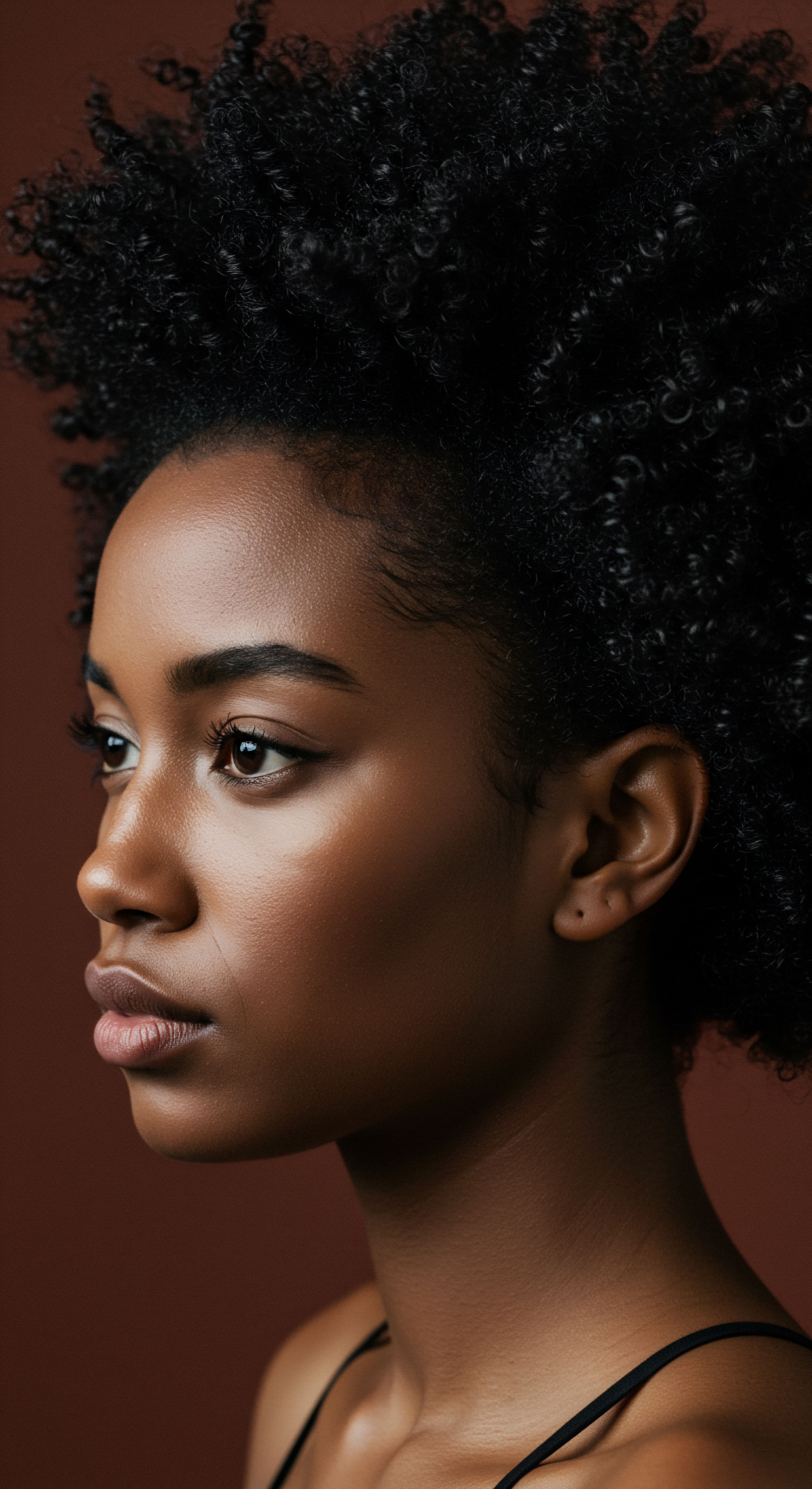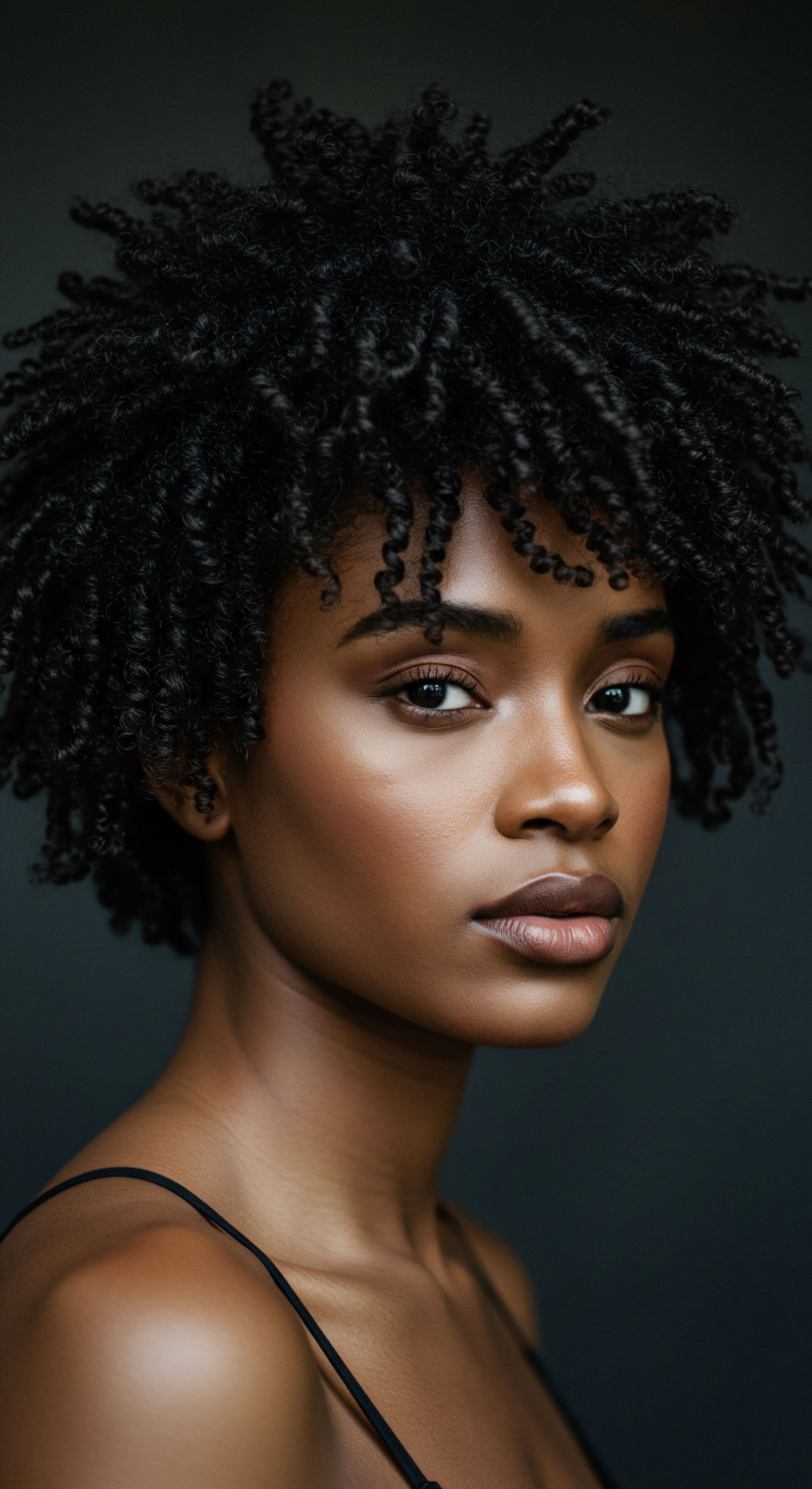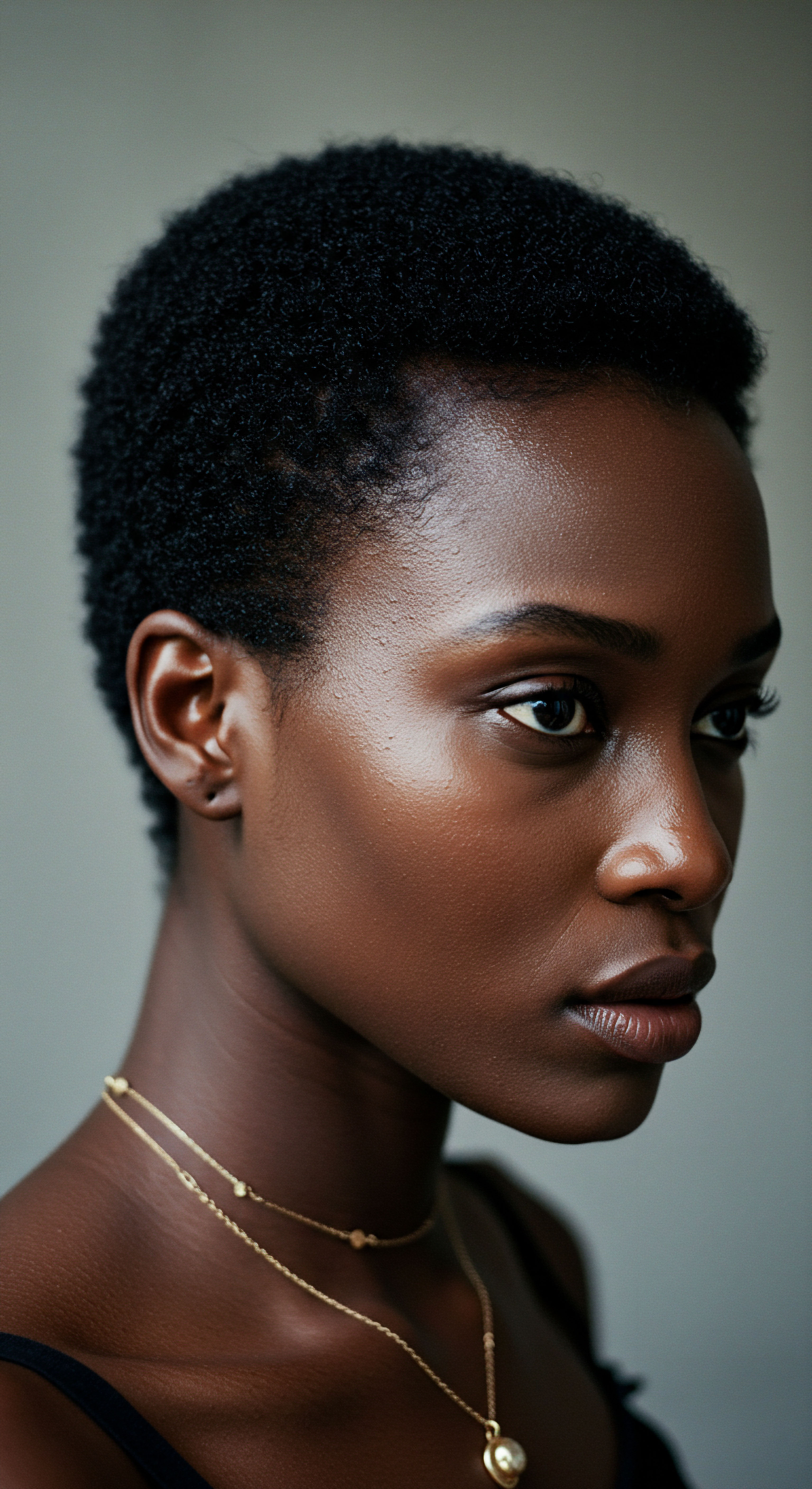
Roots
Have you ever noticed how the very water that cleanses can also, in its silent way, reshape the feeling of your coiled strands? It is a subtle alchemy, often unnoticed, yet deeply impactful on the very nature of our hair. To truly comprehend the intricate dance between water and our textured hair, we must first look to the foundational principles, the elemental truths that govern every strand. Each curl, each wave, possesses an inherent electrical identity, a delicate balance that dictates how it interacts with its environment, particularly the water we use for its care.
Hair, at its fundamental level, carries a slight negative electrical charge, particularly along the edges of its outermost layer, the cuticle. This charge is a natural consequence of the protein structure of keratin, the primary building block of hair. This negative disposition means hair naturally seeks out positively charged elements, like tiny magnets reaching for their counterparts.
When water, the universal solvent, encounters hair, it carries within its liquid embrace a myriad of dissolved substances. The quality of this water, its mineral composition, plays a significant role in this interaction.

Water’s Mineral Presence and Hair’s Electrical Disposition
The term “hard water” describes water with elevated concentrations of dissolved minerals, most notably calcium and magnesium ions. These ions are cations, meaning they carry a positive electrical charge. As these positively charged mineral ions come into contact with the negatively charged surface of coiled hair, an attraction occurs. This is not merely a superficial adherence; it is an electrostatic bond that begins to alter the hair’s surface chemistry.
Hair’s inherent negative charge creates a natural attraction to the positively charged mineral ions found in hard water.
This initial attraction sets the stage for a series of physical and electrical changes. The calcium and magnesium ions begin to settle onto the hair shaft, particularly on the cuticle. For coiled hair, with its unique structural geometry and often more open cuticle layers, this mineral deposition can be especially pronounced. The undulating shape of curls and coils provides more surface area and more opportunities for these mineral guests to cling, creating a layer that can obscure the hair’s natural lustre and suppleness.
The very architecture of coiled hair, with its distinct twists and turns, offers more nooks and crannies for these mineral deposits to accumulate. This means that individuals with textured hair may experience the adverse effects of hard water more acutely than those with straighter hair types. The natural curves can act as collection points, making the removal of these deposits a more considerable challenge. This foundational understanding of hair’s electrical charge and water’s mineral content forms the essential groundwork for comprehending the more complex interactions that follow.
- Hair’s Electrical Charge ❉ Healthy hair typically possesses a slight negative surface charge, especially on its cuticle.
- Hard Water Minerals ❉ Calcium and magnesium are common positively charged ions present in hard water.
- Electrostatic Attraction ❉ The opposite charges lead to minerals binding to the hair surface.

Ritual
Stepping into the daily rhythm of hair care, the seemingly simple act of washing becomes a profound exchange when hard water enters the equation. For many, the familiar feel of lather, the slip of conditioner, and the soft sensation of clean hair are expected parts of this ritual. Yet, when hard water is the medium, these expectations can subtly shift, leading to a daily struggle against an unseen force. The minerals within hard water do not simply sit on the hair; they actively interfere with the very products designed to cleanse and nourish, reshaping the entire washing and styling experience.
Consider the way cleansers interact with water. Shampoos contain surfactants, molecules designed to lift away dirt and oil. In hard water, the positively charged calcium and magnesium ions readily react with the negatively charged components of many shampoos, forming insoluble precipitates commonly known as soap scum. This phenomenon diminishes the shampoo’s ability to create a rich lather and effectively cleanse the hair.
The result is often a feeling of insufficient cleaning, compelling individuals to use more product, which paradoxically can lead to further buildup. This reduction in cleansing efficacy is a direct consequence of the electrical interference at play.

How Minerals Affect Cleansing and Product Performance?
Beyond the diminished lather, the mineral deposits themselves adhere to the hair shaft, forming a rough, scaly film. This film acts as a barrier, preventing conditioning agents and styling products from penetrating the hair’s cuticle and delivering their intended benefits. Hair that once felt soft and pliable after conditioning might now feel stiff, coarse, or resistant to detangling. The smooth, organized structure of the cuticle, which is crucial for light reflection and a soft feel, becomes disrupted by these mineral attachments.
Hard water minerals actively interfere with cleansing agents, diminishing lather and coating hair, which reduces the efficacy of conditioning products.
For coiled hair, this impact is particularly noticeable. The natural spring and definition of curls depend heavily on proper moisture balance and a smooth cuticle layer. When hard water minerals coat the strands, they can weigh down the coils, making them appear limp and less vibrant.
The rougher surface created by these deposits also increases friction between individual strands, leading to greater tangling and, in some instances, heightened frizz. The very definition of the curl pattern can become compromised, leaving hair feeling dry and uncooperative.
The impact extends to styling as well. Products that typically provide hold or definition may struggle to perform as expected on hair laden with mineral residue. The hair’s electrical surface properties are altered, affecting how styling products, many of which rely on specific charge interactions, can bond and shape the strands. What begins as a subtle alteration in the washing ritual can ripple through the entire hair care regimen, influencing everything from detangling to final styling.
| Aspect of Care Shampoo Lather |
| Effect of Hard Water Reduced foaming and cleansing due to mineral interaction with surfactants. |
| Aspect of Care Hair Feel Post-Wash |
| Effect of Hard Water Stiff, rough, and less clean sensation. |
| Aspect of Care Conditioner Absorption |
| Effect of Hard Water Minerals create a barrier, hindering deep conditioning. |
| Aspect of Care Detangling |
| Effect of Hard Water Increased friction and tangling due to rough cuticle surface. |
| Aspect of Care Styling Product Performance |
| Effect of Hard Water Diminished effectiveness as products struggle to adhere or penetrate. |
| Aspect of Care These effects collectively alter the hair's texture and manageability, making daily care more challenging. |
Adapting one’s hair care practices to account for hard water becomes a necessary adjustment. It is a dance of observation and response, seeking out products and methods that can counteract the mineral influence and restore the hair’s natural responsiveness and beauty.

Relay
Moving beyond the immediate sensory experience, we delve into the profound scientific and even cultural interplay between hard water and the electrical properties of coiled hair. This is where the unseen forces reveal their true complexity, where chemistry meets lived experience, and where the history of hair care in diverse communities holds quiet lessons. The electrical properties of hair are not static; they are dynamic, constantly influenced by environmental factors, with hard water standing as a significant, often overlooked, protagonist in this story.
At a microscopic level, the primary components of hard water—calcium (Ca²⁺) and magnesium (Mg²⁺) ions—carry a divalent positive charge. Hair, composed largely of keratin proteins, presents a negatively charged surface, particularly due to carboxylate groups on its amino acid residues. This fundamental electrostatic attraction is the basis of mineral deposition. When these positively charged ions encounter the negatively charged hair, they bind, creating a mineral coating.
This coating is not inert; it actively modifies the hair’s surface charge, altering its zeta potential. The Zeta Potential, a measure of the electrical charge at the shear plane of a particle in a liquid, provides a quantitative insight into this interaction. A shift in the zeta potential indicates a change in the hair’s surface chemistry and its propensity to interact with other charged molecules, including water itself and hair care products.

How Does Mineral Deposition Alter Hair’s Surface Chemistry?
The deposition of these minerals can cause the hair cuticle scales to lift. A smooth, overlapping cuticle layer reflects light, leading to shine, and acts as a protective barrier, retaining moisture. When mineral deposits interfere, the cuticle becomes ruffled, leading to a dull appearance and increased porosity. This increased porosity, in turn, can make hair more susceptible to moisture loss and environmental damage.
The mechanical integrity of the hair also suffers. A study conducted by Luqman et al. in 2018 examined the impact of hard water on hair strength. The researchers found that the mean tensile strength of hair samples treated with hard water (234.16) was significantly lower compared to those treated with deionized water (254.84), with a statistical significance of P = 0.001. This measurable reduction in tensile strength underscores the physical compromise hard water imparts on hair, making it more vulnerable to breakage, particularly for delicate coiled strands that are already prone to mechanical stress.
An interesting, perhaps less commonly discussed, aspect of this mineral uptake relates to the hair’s condition. Research suggests that the extent of metal ion uptake by hair is primarily a function of the hair’s existing condition. Even in soft water, hair that has undergone chemical treatments, such as bleaching or coloring, or sustained mechanical damage, can absorb substantial amounts of water hardness metals.
This implies that individuals with damaged coiled hair, regardless of their local water hardness level, might still experience mineral buildup and its associated electrical and structural challenges. This highlights a critical, often overlooked, aspect of hair health ❉ the vulnerability of compromised strands to environmental influences.

Do Cultural Hair Practices Adapt to Water Hardness?
Across diverse cultures, hair care traditions have long adapted to local environmental conditions, including water quality. In regions historically known for hard water, communities may have intuitively developed practices or utilized natural ingredients that act as chelating agents, helping to mitigate mineral buildup. For instance, acidic rinses, such as those using fermented rice water or fruit vinegars, common in various ancestral hair care rituals, can help to protonate the anionic sites on hair, making them less attractive to positively charged mineral ions and helping to dissolve existing deposits.
This cultural wisdom, passed down through generations, often predates scientific understanding yet aligns with the principles of chemistry. It speaks to a deep, communal knowledge of hair and its delicate equilibrium with nature.
Damaged hair absorbs more minerals regardless of water hardness, highlighting a crucial vulnerability.
The long-term implications of hard water exposure on coiled hair extend beyond mere aesthetics. Persistent mineral accumulation can lead to chronic dryness, as the film prevents moisture from penetrating the hair shaft. This can exacerbate frizz and contribute to a feeling of stiffness, making detangling a difficult and damaging process. Furthermore, the altered surface charge can affect the hair’s interaction with humidity, potentially leading to more pronounced static electricity or unmanageable puffiness.
For those with colored hair, hard water can cause discoloration, leading to brassy or dull tones, as the minerals react with hair dyes. The scalp, too, is not immune; mineral deposits can contribute to dryness, irritation, and flaking, disrupting the healthy environment necessary for hair growth.
Understanding these multifaceted impacts, from the micro-electrical interactions to the macro-level cultural adaptations, allows for a more holistic approach to caring for coiled hair in hard water environments. It calls for a thoughtful selection of products and practices that acknowledge the water’s role in the hair’s overall well-being.
- Mineral Binding ❉ Calcium and magnesium ions bind electrostatically to the negatively charged sites on hair proteins.
- Cuticle Disruption ❉ Mineral deposits cause cuticle scales to lift, leading to increased porosity and reduced shine.
- Tensile Strength Reduction ❉ Hard water exposure can significantly decrease hair’s resistance to breakage.
- Damaged Hair Vulnerability ❉ Compromised hair absorbs more hard water minerals, irrespective of water hardness levels.

Reflection
As we consider the profound interplay between hard water and the electrical properties of coiled hair, a deeper appreciation for the delicate chemistry of our strands emerges. The journey from understanding the unseen mineral guests in our water to observing their impact on hair’s electrical charge, and then recognizing the cascading effects on texture and strength, reveals a continuous dialogue between our environment and our physical selves. This exploration is not simply about identifying a problem; it is an invitation to listen more closely to our hair, to discern its subtle cues, and to respond with wisdom and intention.
Each coil, with its unique structure and inherent electrical disposition, stands as a testament to nature’s diverse artistry. When we acknowledge the role of something as fundamental as water in shaping its vitality, we are reminded of the interconnectedness of all things. This understanding empowers us to approach hair care not as a series of disconnected steps, but as a holistic practice, honoring both scientific principles and ancestral wisdom. What more might we learn when we approach our hair with such curiosity and respect?

References
- Alahmmed, L. M. Alibrahim, E. A. Alkhars, A. F. Almulhim, M. N. Ali, S. I. & Kaliyadan, F. (2017). Scanning electron microscopy study of hair shaft changes related to hardness of water. Indian Journal of Dermatology, Venereology, and Leprology, 83(6), 740.
- Evans, R. J. Marsh, J. M. & McMichael, B. (2011). The structural implications of water hardness metal uptake by human hair. Journal of Cosmetic Science, 62(3), 253-263.
- Luqman, M. Amin, S. & Khan, I. (2018). To Evaluate and Compare Changes in Baseline Strength of Hairs after Treating them with Deionized Water and Hard Water and its Role in Hair Breakage. International Journal of Trichology, 10(3), 113–117.
- Srinivasan, G. Chakravarthy, V. S. & Rangachari, S. (2015). Scanning electron microscopy of hair treated in hard water. Indian Journal of Dermatology, 60(6), 633.
- Marsh, J. M. & Evans, R. J. (2007). The uptake of water hardness metals by human hair. International Journal of Cosmetic Science, 29(4), 283-290.